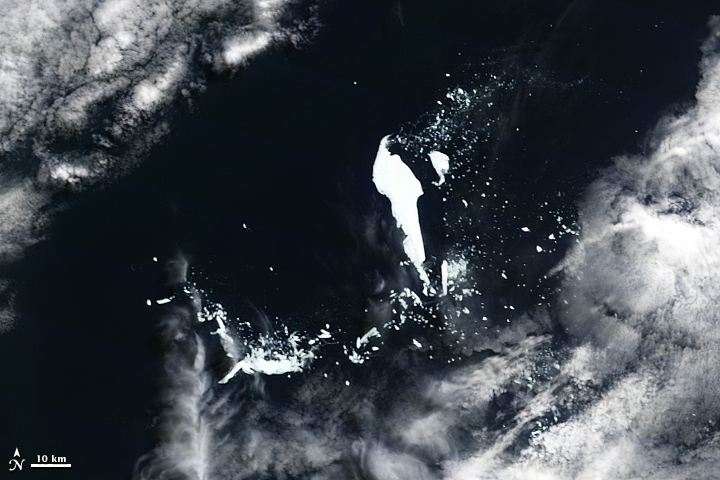
Iceberg Remnant Still Floating 11 Years Later

From NASA's Earth Observatory:
Ice shelves are thick slabs of ice that stretch from land over nearby ocean water. The world’s largest ice shelves are in Antarctica, and the biggest of these is the Ross. As part of a natural cycle, ice shelves periodically calve icebergs, and in March 2000, the Ross Ice Shelf calved an iceberg nearly the size of Connecticut. Named B-15, it was one of the largest icebergs on record. B-15 broke into smaller pieces, but by remaining in a cold climate, some of those pieces lasted more than a decade.
One fragment of B-15, named B-15J, was still in existence in early December 2011. B-15J had traveled far from Antarctica by then, and was breaking into smaller pieces. The Moderate Resolution Imaging Spectroradiometer (MODIS) on NASA’s Terra satellite captured this natural-color image of B-15J on December 2, 2011.
Sliver-shaped pieces of ice formed an arc around the oblong iceberg, which had disintegrated discernibly since late November. B-15J and the smaller ice fragments were roughly 2,400 kilometers (1,500 miles) east-southeast of New Zealand. Just as remaining near Antarctica allowed this iceberg to persist for more than a decade, floating into warmer waters prompted it to break apart. An iceberg from the Larsen Ice Shelf on the Antarctic Peninsula underwent a similar disintegration in 2008.
As of late November 2011, several other remnants of Iceberg B-15 were still in existence, including B-15B, B-15F, B-15G, B-15K, B-15R, B-15T, and B-15X.
Sign up for the Live Science daily newsletter now
Get the world’s most fascinating discoveries delivered straight to your inbox.










